
You have read about the exterior of the earth in previous chapters of your book, here I am going to explain to you the interior of earth in very simple language . so let’s deep dive into the topic and understand what the earth’s interior means and how it helps us understand the world.
Types to Study the Interior of Earth :
There are two types of Direct and Indirect sources through which we study.
Direct source:
We come to know about the Earth from direct sources which means we get material directly from the Earth and your research team studies and researches about the Earth. For example,
- volcanoes up to 400 km mean the area from where magma erupts out means the origin of magma eruption it helps a lot of scientists to study the interior earth.

2. Digging: it means when you dig the earth up to 100 km it also helps you to study the interior of earth.
3. Mining: Mining also helps you to study the interior earth, because when you bring out the material from the earth it also contains minerals, ores, and precious rocks that define a lot about the earth.
4. Holes: it is also made for experiments, holes are made up to 1200km
Limitations:
They do not tell us beyond 400 km.
it also gives us limited information.
Indirect Source:
Here you can not find any material or sample like you found in a direct source.

Interior of Earth ( source – Wikipedia)
Characteristics of the interior of Earth:
- Temperature: The temperature of the earth changes as we go down from the surface of the earth, every 32 meters 1-degree increases which means for 3200 km 1000 degrees Celsius increases and 6400 km it increases by 2000 degrees Celcius.
- The density of Earth’s interior: the formula of density is Mass/volume therefore according to that if you use the gravitational formula that is G1 G2/mr2, the average density of the Earth is equal to 5.5 gm/cm cube. The density of earth continental rocks = 2.7 gm/cm cube and the density of oceanic rocks is equal to 3 gm/cm cube.

3. Pressure: it tells you about the state of the interior and one important thing is as temperature increases pressure also increases, unlike the atmosphere.
4. Space objects: Because the earth and space objects were made of the same material during the making of the solar system you can understand the material of the earth. for example, space objects Moon, Mars, Venus, other planets, Meteriots, Asteroids etc.it means the material present in space object is similar in the interior of earth.in next article I will define this .
5. Earth’s Internal Forces and Energies: 1 ) gravity and its gravitational field and change in gravity values because gravity is a fundamental force, it pulls the objects towards Earth’s centre. Gravity’s strength can vary due to differences in Earth’s mass underground. Areas with denser rock have stronger gravity. Scientists study these variations to learn about the earth’s internal structure and processes.
2. Earth’s Magnetic field:
3. Seismic Energy of Earth’s interior: Energy released in Earth’s interior when any sudden release of such energy takes place ( such energy develops Earth’s interior due to compression, divergent, tension, convergence frictional movements which are generally tectonic movements, sudden volcanic activities can cause seismic activity in tectonic.
Q1. How does seismic energy help us to understand Earth’s interior?
seismic energy travels from the hypocentre in all directions travelling through the body of the earth the same ways as light from a bulb travels in all directions inside a spherical lampshade and glows the whole surface with lamp shade, the seismic forces are expected to travel throughout the body of earth and reach all place on surface of the earth. s Seismic waves passed through the body of the earth hence they can tell us the interior of the earth. This is why seismic waves are very important in understanding the Earth’s interior.
The seismic waves are of two types in interior of earth :
- Body waves: it has itself two types P and S waves. ( 2023 asked in upsc prelims), P waves are fast and pass in solid, liquid and gas states. P waves bend when pass from one medium to another medium and the density. P waves are longitudinal it seems expansion, and contraction are in the same direction as wave directions. S waves are slower and are transverse like shaking a blanket, S waves pass only in solid, liquid and gas ends.
- Surface wave: it is also called Rayleigh wave and Love wave, you know during earthquakes we experience these waves. these are Transverse waves which means that they vibrate perpendicular to the direction of wave movement. The Love wave is snake movement it is horizontal and the Rayleigh wave is transverse like water waves.
S Wave in interior of earth.
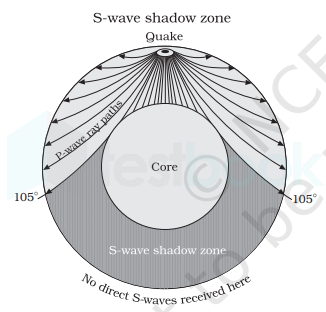
You might expected that S wave should travel through out the body of interior of earth and reach all the surface of interior earth in all directions.But actually observation is above image .no matter when an earth quick came or where the epicentre was, the angle where the s waves appears on earth surface with respect to that epicentre is always constant 105/103.

It means there must be region in earth’s interior which is not solid and have S waves are not able to pass that region hence they die there are S waves which are suppose to appear 105 – 180 degree this region cannot be gaseous as gases can never be denser than solid hence this region must be in liquid state . there is liquid state region in interior of earth.
Shape of liquid region in interior of earth :
It can be determined from constant angle 105 up to which S wave appears with respect to any epicentre and any earthquake . we can definitely say that this liquid regionshould have a spherical shape so that the S waves not entering this liquidregin but are able to appear up to 105 degree if the S waves enter into this regiondies at surface and are not pass in liquid zone.
By better understanding the bending calculationwe have been able to find out that this liquid zone.
Liquid zone is 2900 kms from surface of earth, liquid zone is called the core of the earth.
P wave in interior of earth :
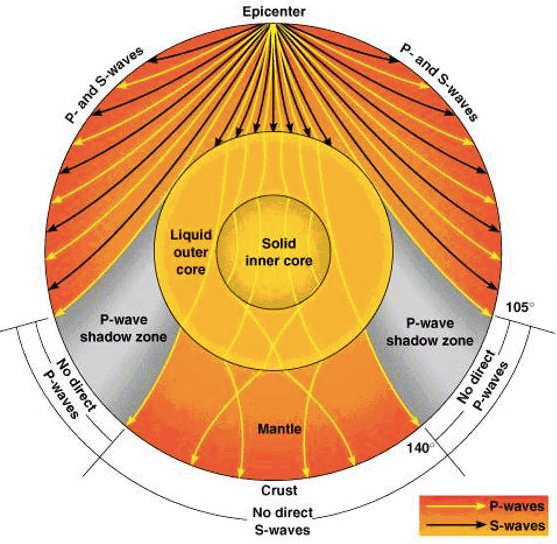
As we in actual observation diagram for P waves, the P waves do not enter the liquid core , it appears on surface of earth from 0 degree with respect to epicentre up to 105/103 degree but the p waves that enter the liquid core are not able to appear on earth’s surface before 145 degree than they appear, hence the region from 105/145 degree is known as P wave or shadow zone
Density of innercore can be determined by P wave deflection as P wave deflection is directly proportional density difference .

Using all the above observations the final picture of earth’s interior has been understand as below
Final understanding of Earth’s Interior
To understand interior of earth we should know two things what it is made up of ( chemically) and to what state is it ( physically) to understand interior of earth we have to understand chemical characteristics which means what it is made of as well as physical characteristics which means what state it is.
Chemically:
- Crust: The first layer of the crust is divided into 2 parts oceanic crust and Continental crust. The oceanic crust has a 5 km thickness whereas the continental crust has a 30 to 70 km thickness. It is made up of Silica and aluminium
- Mantle: it is the second layer in the interior of the earth which is 2900 km. It is made up of Silica and magnesium
- Core: centre of the earth.it is made up of Nickel and Iron.
Physical characteristics of interior of earth :
As we know the interior of Earth are inner core and outer core, inner core is made up of solid material and outer core is liquid that leads convection which generates magnetic field , Menatl and crust are solid, but yet they are not in the same solid state. there is a upper layer known as lithosphere which means sphere of rock solid layer which comprises of whole of crust that is oceanic crust to continental crust plus top rock solid part of mental.
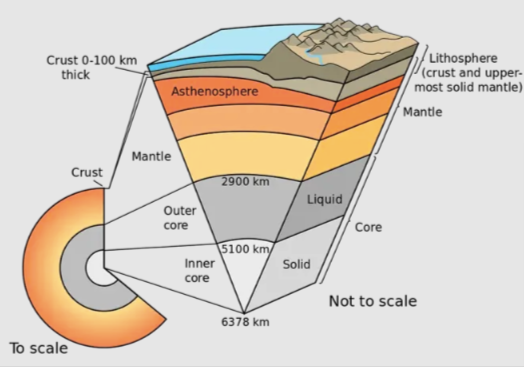
Thinkness of lithosphere varies ( oceanic lithosphere = 10 km and continental lithosphere = plains 100 km and mountains = 200 km.
Asthenospher: it is plastic and week in nature, it is made up of magma.
Mesosphere: solid state
Barrysphere: it consists whole oof core and is made up of both solid and liquid.
Which zone separate different layers in interior of earth :
The zones which seperetae these chemical and physical layers are known as discontinuity.
1.Upper and lower crust ________ CONARD DISCONTINUITY .
2. Upper and lower Mantle ———— MOHOROVIC
3. Middle Mantle and Lower Mantle————–REPPITTI
4 Mantle and core———————– GUTENBERG
5. Upper core and lower core—————- LEHMAN BULLEN.

Latest Mcqs about interior of earth
A) the crust of the earth
B) mantle of earth
c) the outer core of the earth
D ) the inner core of earth
Answer) the crust of the earth
Interior structure of the earth MCQ Quiz – Objective Question with Answer for Interior structure of the earth – Download Free PDF
From the examination points of view of different competition exams, it is one of the most important topic of geography. Interior structure of earth defines the various layers of the earth. It comprises crust, mantle, core. Crust are divided into two parts i.e., oceanic crust (Si- ma) and continental crust (Si-al). Mantle is the layer between core and crust which has two layers called asthenosphere and Pyrosphere. Core is last layer where gutenberg discontinuity occurs. Learning the various layers of the earth and their composition and revising the concept of various discontinuities at different layers would help to complete the topic in more precisely and would help to ace this topic.
Latest Interior structure of the earth MCQ Objective Questions
Interior structure of the earth Question 1:
The earth’s plate responsible for causing earthquakes is
- the crust of the earth
- the mantle of the earth
- the inner core of the earth
- the outer core of the earth
Answer (Detailed Solution Below)
Option 1 : the crust of the earth
Interior structure of the earth Question 1 Detailed Solution
The correct answer is the crust of the earth
Key Points of interior of earth
- Earthquake:
- In an earthquake, huge masses of rock move beneath the Earth’s surface and cause the ground to shake.
- Earthquakes occur constantly around the world.
- Often they are too small for people to feel at all.
- Sometimes, however, earthquakes cause great losses of life and property.
- An earthquake is a sudden shaking or trembling of the earth which lasts for a very short time.
- Most earthquakes are caused by the movement of the earth’s plates.
- Why does the earth shake?
- An earthquake is caused by a disturbance deep inside the earth’s crust.
- The release of energy occurs along a fault.
- A fault is a sharp break in the crustal rocks.
- Rocks along a fault tend to move in opposite directions.
- As the overlying rock strata press them, the friction locks them together.
- However, their tendency to move apart at some point in time overcomes the friction.
- As a result, the blocks get deformed and eventually, they slide past one another abruptly.
- This causes a release of energy, and the energy waves travel in all directions.
- The point where the energy is released is called the focus of an earthquake, alternatively, it is called the hypocentre.
- The energy waves travelling in different directions reach the surface.
- The point on the surface, nearest to the focus, is called the epicentre.
- It is the first one to experience the waves.
- It is a point directly above the focus.
Thus, the earth’s plate responsible for causing earthquakes is the crust of the earth.( interior of earth)
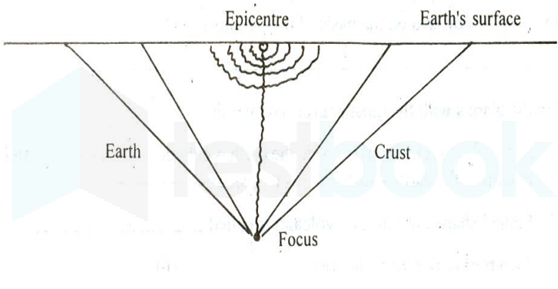
Additional Information
The interior of the earth can be divided into 3 different layers – crust, mantle, and core.
| Layer | Characteristics |
| Crust | The uppermost layer over the earth’s surface is called the crust.It is the thinnest of all the layers.It is about 35 km on the continental masses and only 5 km on the ocean floors.The main mineral constituents of the continental mass are silica and alumina. It is thus called sial (si-silica and al-alumina).The oceanic crust mainly consists of silica and magnesium; it is therefore called sima (si-silica and ma-magnesium)The crust makes up only 1% of the volume of Earth. |
| Mantle | Just beneath the crust is the mantle which extends up to a depth of 2900 km. below the crust.The mantle is semi-liquid, sort of like a malleable plastic, and makes up 84% of Earth’s volume. |
| Core | The innermost layer is the core with a radius of about 3500 km.It is mainly made up of nickel and iron and is called nife (ni – nickel and fe – ferrous i.e. iron).The central core has very high temperature and pressure.The crust makes up only 15% of the volume of Earth. |
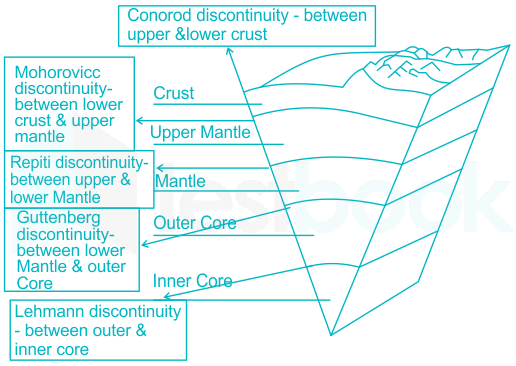
Read more and other topics in simple language and update yourself visit Instagram / Facebook
Read other topics visit : https://mateenahaya.com/biosphere-reserve/
20 facts about interior of earth
1. In 1692 Edmond Halley (of comet fame) proposed that the interior of Earth is hollow. Below the outer crust where we live, he pictured two concentric shells and a core about the size of Mercury, all floating in a luminous gas.
2. Helloooo down there: Halley even imagined that these shells might be inhabited. Jules Verne riffed on this idea in his classic Journey to the Center of the Earth.
3. Halley was right about the planet-size core, at least. At Earth’s center is an iron-rich orb more than 4,000 miles wide — bigger than Mercury, actually — closer to our feet than L.A. is to New York.
4. Its outer part is molten. Its inner part is a solid hunk of metal that spins independently of the rest of the planet.
5. Earthquake waves that pass through the inner core travel faster north-south than they do east-west. One theory: The inner core consists of metallic crystals aligned with Earth’s poles, and the waves move more rapidly when they go with the grain.
6. The inner core is nearly as hot as the surface of the sun, and the pressure down there is 3 million times what it is on the surface.
7. Earth’s solid and liquid cores together generate the magnetic field that keeps the solar wind — a nonstop, 250-mile-per-second stream of charged particles emitted by the sun — from stripping away our atmosphere.
8. Earth’s mini-me: A group at the University of Wisconsin is attempting to model Earth’s field by bottling 500,000-degree plasma in a 10-foot-wide aluminum sphere with really solid walls. The currents inside should mimic flows in the outer core.
9. The deepest place ever reached by human technology is the Kola Superdeep Borehole near Murmansk, Russia, the product of a Cold War inner-space race.
10. Bacteria have been discovered in the cavities and cracks of gold mines 2.4 miles beneath Earth’s surface. They live on hydrogen and sulfates, and their primary source of energy is radiation, not the sun. Yum.
11. Microbiologist James Holden of the University of Massachusetts at Amherst speculates that our planet’s deep biomass could weigh as much as all the things living up here on the surface.
12. According to NASA scientists, life on Mars may be huddling out of sight in a similar deep, hot biosphere.
13. Change is inevitable, even in the core. Examining paleomagnetic data, geoscientists at Johns Hopkins University suggest that the eastern and western halves of Earth’s core take turns growing and melting.
14. That may be why the axis of Earth’s magnetic field is cockeyed, leaning these days to the east, while a few geologic eyeblinks ago it tilted to the west.
15. The Johns Hopkins researchers think the axis gets anchored in the growing half. Which could account for our planet’s weird history of magnetic field reversals, with north and south poles swapping places.
16. Such magnetic field quirks might also be explained by pandemonium at the boundary between the molten core and the overlying mantle.
17. Berkeley physicist Richard Muller speculates that oxygen, silicon, and sulfur are being squeezed out of the inner core and floating up to the core-mantle boundary, where they collect into hot, slushy dunes. Every once in a while, one dune may violently tumble into the mantle, revving up convection and disturbing the magnetic field.
18. Reduce, reuse, recycle. The slow churn of plate tectonics pulls crust into the interior, where any plant and animal life in it gets trapped and cooked. Organic material eventually resurfaces in lava and volcanic gases, including atmosphere-warming carbon dioxide.
19. Such cycling, and the protective magnetic field generated by the core, keep our planet at the perfect temperature for life.
20. Look at Venus, with its 900-degree Fahrenheit days and nights. If not for our planet’s restless insides, that could be us.
I hope the interior of earth topic is clear to you lets do one Mains question on inte rior of earth topic
Q1. What evidence from seismic waves helps scientists understand the interior structure of the earth? Explain how the different layers( crust, mantle, core were discovered using the evidence and why it is important for studying earthquakes and volcanoes.
Ans)
- Seismic waves behave differently as they travel through Earth, revealing its layered structure based on density and composition.
- Earth’s interior is composed of distinct layers: the solid crust, the viscous mantle, and the dense core.
- Seismic data identifies important boundaries like the Moho, which separates the crust from the mantle.
- Understanding Earth’s interior is crucial for studying geological phenomena such as earthquakes and volcanoes.
- Seismic waves provide insights into Earth’s composition, dynamics, and the behavior of seismic activity in different regions.
I give you hints please write 150 word answer by own and read again interior of earth and check previous year questions on interior of earth
Pingback: Top 5 indian infrastructure project ( Best for upsc 2024)
Informative content… thanks ma’am